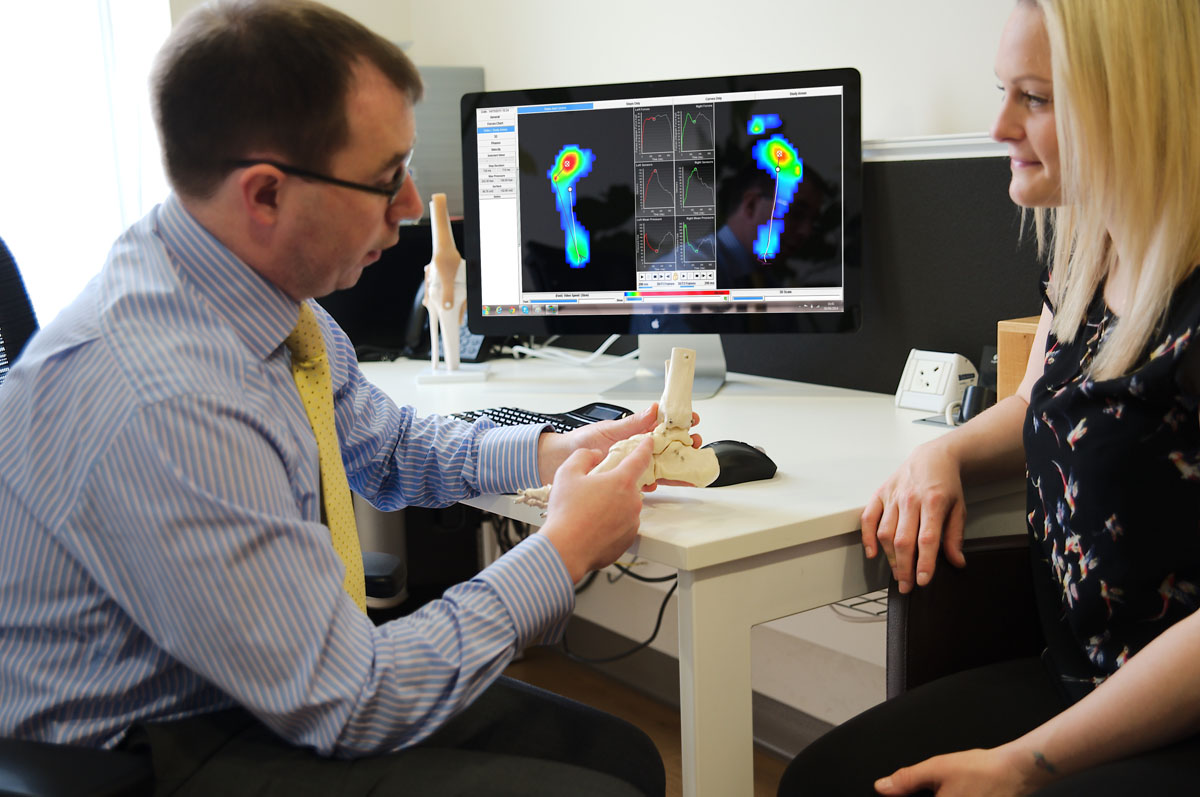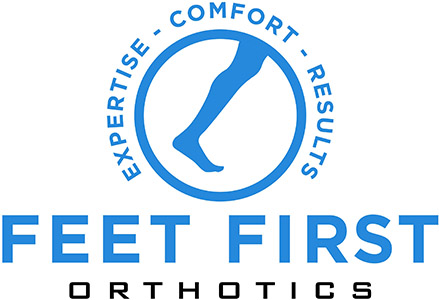General Foot Problems
The human foot is a mechanical and medical marvel.
It can sustain enormous pressure (several tons over the course of a one-mile run) and provides flexibility and resilience during the thousands of steps we make every day.
- Plantar Fasciitis
- Hallux Valgus (Bunions)
- Metatarsalgia
- Over Pronation
- Morton’s Neuroma
- Tibialis posterior tendon dysfunction
- Achillies Tendonitis
- Pes Cavus (High Arched Foot)
Foot pain is not normal and should not be ignored but unfortunately, it often is. Unbeknown to many, problems with the feet can actually affect the functioning of other parts of the body including the hips, knees and back.
Some of the most common foot problems, along with their symptoms are listed below.
Plantar Fasciitis
The plantar facia is a thick and fibrous band that runs along the plantar surface of the foot. It originates in the heel bone and fans along the bottom of the foot before inserting into the base of the toes. It acts as a “bowstring ” and helps maintain the shape of the arch. Inflammation of this fibrous band is known as Plantar Fasciitis.
Symptoms
- Pain is usually felt in the heel but this discomfort can also radiate along the arch of the foot. As we spend most of our time on out feet it is very hard to be able to rest the inflamed fascia. This long-standing and untreated inflammation can lead to the deposition of calcium near the insertion point and can result in the formation of a heel spur.
- It is common for most of the pain to be felt in bare feet first thing in the morning as the arch becomes stretched after a night of rest and contraction of the fascia.
Causes
- Pain and inflammation occurs when this inflexible fibrous band is over starched due to an over pronation foot, an increase in weight i.e. pregnancy, a tight achilles tendon or a sudden increase in activity.
Treatment
- Treatment of Plantar Fasciitis can be treated initially by a guided injection to ease the discomfort felt. A more long-term form of treatment is the provision of a Functional Foot Orthosis. The aim of this is to control the foot mechanics and prevent over stretching of the plantar fascia. An element of cushioning is also provided by the Orthoses in order to give relief from a possible bony spur.
Hallux Valgus (Bunions)
Hallux Valgus, or Bunions as they are commonly known, are one of the most common forefoot deformities. It is the displacement of the joint of the big toe and results in the big toe turning and rotating inwards. The shifting of the toe inwards results in a very painful prominence on the side of the big toe joint.
Symptoms
- The symptoms are a red and bony growth over the outside of the big toe joint. A turning in of the big toe will also be seen. Stiffness in the big toe and resultant callus and discomfort under the second toe joint can also be symptomatic of a bunion.
Causes
- There are three main causes for bunions. The first is genetic, if either of your parents have them then there’s a high chance you will have them too. Second is the wearing of footwear that is too narrow across the joints of the foot, resulting in the feet taking up the shape of the shoe.
- The last main cause is Rheumatoid Arthritis – an autoimmune disease that results in the deformation of the joint capsules. Over pronation and flat feet can also cause excessive pressure over the first toe joint resulting in the migration of the big toe and development of a bunion.
Treatment
- Surgery to straighten the big toe joint and remove the bony prominence is a very popular and in most cases, successful procedure. It is very likely that your consultant will refer you to see an Orthotist after the swelling has gone down for some Functional Foot Orthotics in order to compliment the surgery and reduce the chances of recurrence. Most people however tend to see an Orthotist for treatment in order to prevent the need for surgery and in most cases this can really help. The treatment will involve a pair of Functional Foot Orthotics and also some wider fitting footwear.
Metatarsalgia
Metatarsalgia is the general term used to describe forefoot pain. The usual comment by a patient is “it feels as though I’m walking on pebbles”. These “pebbles” are usually the 2nd, 3rd and 4th metatarsal heads and can be caused by a number of reasons.
Causes
- An over pronating foot can result in excessive forefoot pressure. High-heeled shoes result in all the pressure being taken through the forefoot during walking. Footwear with a narrow toe box can cause the ball of foot area to be forced into a minimal amount of space. This can inhibit the walking process and lead to extreme discomfort in the forefoot. As we get older the protective pad under the forefoot also becomes thinned which can result in further pain.
Treatment
- Before treating metatarsalgia it is important to ascertain the exact cause. From this, the correct Functional Foot Orthosis can be prescribed in order to control the foot mechanics and off-load the areas of the foot that are experiencing excess pressure.
Over Pronation
- The most common condition that results in foot/knee/hip and back pain is over pronation. Pronation is a very natural and necessary movement during walking and acts as a method of shock absorption. Excessive pronation causes the arch to collapse, flatten and the soft tissues to over stretch. This causes the joint surfaces to function at unnatural angles to each other. When this happens, joints that should be stable become very loose and flexible.
Symptoms
- During standing, the heels of your feet turn outwards as your knee caps turn inwards. Pain can be felt across the crease of the foot and up the front of the leg as well as pain in the knees during and after activities. Abnormal wear can occur to the soles of your shoes as well as excessive callus under your big toe joint and potentially bunions.
Causes
- Over Pronation occurs due to ligament laxity and biomechanical dysfunction.
Treatment
- The best way to treat an over pronating foot is with a pair of Functional Foot Orthotics. These will control and correct the biomechanical dysfunction and as a result reduce pain and help with the above conditions.
Morton’s Neuroma
The term neuroma refers to a swelling of a nerve. The nerve commonly affected is a small nerve that connects the 2nd & 3rd and 3rd & 4th toes.
Symptoms
- Numbness or tenderness is felt in the forefoot, just behind the joints of the toes. As the neuroma progresses, pain, numbness and a tingling sensation can be felt which radiates further down towards the toes. The numbness can feel worse when a tight pair of shoes are worn with relief being felt when the foot is rested and not in footwear. An “electric shock” that runs up the leg can also be experienced during sleep.
Causes
- The development of a Morton’s Neuroma occurs due to friction and pressure experienced by the nerve that runs between metatarsal shafts of the foot. Over pronation can also affect the mechanics of the foot and put the it under unwanted stress, which increases the likelihood of a neuroma occurring.
Treatment
- An MRI can be used to diagnose the neuroma. Surgery can be done in order to remove it and some Functional Foot Orthoses can be provided after the surgery in order to prevent reoccurrence. Alternatively, if surgery is not an option a similarly designed Functional Foot Orthosis can be provided that will increase the spaces between the metatarsal shafts and reduce the pressure experienced by the neuroma.
Tibialis posterior tendon dysfunction
This is a very common condition of the foot and is sometimes called an “acquired flat foot” as it is the posterior tibial tendon that holds the arch and prevents the foot from rolling in.
Symptoms
- Symptoms of PTTD include a painful instep and the appearance of a sudden flat foot. There may also be a burning or tingling sensation, present in the foot. This is due to the inflammation of the nerve that surrounds the tendon.
Causes
- A very tight achilles tendon can cause PTTD. Running and lots of walking up hills can cause it also. Those with a flat foot type are also susceptible to PTTD.
Treatment
- R.I.C.E (rest, ice, compression and elevation) can be beneficial in the early stages of rupture. However the recognised and most successive way of treating PTTD is with a Functional Foot Orthosis to help control the mechanics of the foot and prevent further degeneration.
Achillies Tendonitis
As the name suggests, Achilles Tendonitis affects the achilles tendon that connects the calf muscles to the heel bone of the foot.
Symptoms
- Symptoms of achilles tendonitis are usually mild at first but can increase if ignored. This pain may be present during activity and worsen once an activity has ceased. Increased wear around the heels of your shoes is a good indication of achilles tendonitis.
Causes
- The causes of achilles tendonitis are many but one of the main contributing factors is ignoring the pain, allowing it to worsen. Excess pronation of the foot results in an increased amount of strain experienced by the tendon causing inflammation. Women are more susceptible to this condition as they wear high-heeled shoes resulting in a contraction or shortening of the tendon. Once a flat shoe is then worn, an increased stretch is required by the tendon, resulting in achilles tendonitis.
Treatment
- The aim of a Functional Foot Orthosis is to control the amount of pronation that is experienced by the foot during normal walking. By controlling the pronation, the tendon is not allowed to be over-stretched and allows it to heal. For those that do wear high hells, it is advised that hamstring and achilles stretches are done on a regular basis.
Pes Cavus (High Arched Foot)
Most people have an arch on the inner side of their foot. Those that over pronate have a very low or in some cases, no arch. The opposite to this is a high arch and is known as a cavus foot type.
Symptoms
- The symptoms for pes cavus are dependent on the severity of the foot shape. A good indicator of a cavus foot shape is a foot that has a high build up of callus under the 1st and 5th toes. Like most conditions of the foot, there will be an increase wear pattern on the soles of your footwear. Knee and hip pain is likely in the most sever cases. Stiffness within the foot and ankle is also very common.
Causes
- It is thought that the cause of a pes cavus foot position is hereditary but in most cases the reason is unknown.
Treatment
- A Functional Foot Orthosis can be prescribed in order to distribute pressures experienced by the foot and reduce the build up of callus, which can be painful and also ease the strain on the arch and foot.


 If you would like to make an appointment please contact practice manager Claire Stevens.
If you would like to make an appointment please contact practice manager Claire Stevens. Nick Gallogly, Royal Berkshire NHS Foundation Trust’s Clinical Lead for Department of Orthotics has been appointed as a Consultant Orthotist – the second person in the UK and Ireland to be in such a post.
Nick Gallogly, Royal Berkshire NHS Foundation Trust’s Clinical Lead for Department of Orthotics has been appointed as a Consultant Orthotist – the second person in the UK and Ireland to be in such a post.